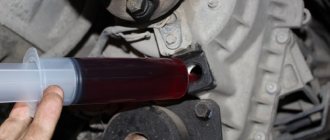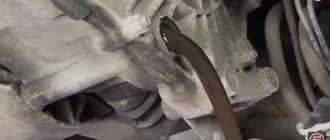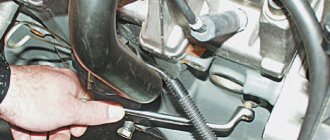The Chevrolet Lacetti manufacturer implies that replacing the transmission lubricant is necessary only in case of transmission repair. There is not even a drain hole in the pan. But the experience of car enthusiasts suggests that severe operating conditions, for example, driving on rough roads, traffic jams and low temperatures, quickly wear out the lubricant. As a result, the oil loses its protective properties, and the gearbox mechanism begins to collapse. This affects operation by poor gear shifting, knocking and noise from the gearbox.
Do-it-yourself recommendations for changing the oil in a Chevrolet Lacetti manual transmission.
Therefore, timely replacement of lubricant is a necessary measure in order to prevent malfunctions and extend the service life. An incorrectly performed procedure will result in damage to the transmission unit. Changing the oil in a Lacetti box can be done either at a service station or independently if you have a little skill.
What kind of oil should I put in the Lacetti gearbox?
All transmission oils are classified into two groups, independent of each other.
By viscosity index - SAE
By operating parameters - API
SAE Viscosity Classification
According to this classification, there are 9 degrees of viscosity of oils for mechanical transmissions: winter - 70W, 75W, 80W, 85W, summer - 80, 85, 90, 140 and 250. If the lubricant is suitable for both seasons, its marking includes a combination of two numbers: SAE 75W-85, etc. All-season gear oils have become more widely used.
| Ranges of application of transmission oils | ||
| Minimum temperature for ensuring lubrication of components, °C | SAE class | Maximum ambient temperature, °C |
| -40 | 75W-80 | 35 |
| -40 | 75W-90 | 35 |
| -26 | 80W-85 | 35 |
| -26 | 80W-90 | 35 |
| -12 | 85W-90 | 45 |
Ideal for the Lacetti, from my point of view, is either 75W-90 or 75W-80. Although lately our winters have become warm, so personally in my region you can look towards 80W-90
Note
It is important to understand that the oil is selected not based on the name of the car, but on the climatic conditions where the car is operated. I live in a temperate climate
Our temperature practically never goes below -15 or above +30. Therefore, if you operate a car in Siberia or Africa, then your oil parameters should be different.
Classifier by API
The purpose, quality and performance properties of gear oils are described by the API classifier. The division principle in this system is based on the constructive use of the lubricant and the conditions of its use. The API also takes into account the content of extreme pressure and anti-wear additives in the lubricant. Transmission products are designated API GL with the addition of the number 1...5. Consequently, the classifier divides all lubricants for transmission units into 5 groups
I will not describe all five groups. I will only say that for the Chevrolet Lacetti you need to use only API GL-4. You should not take API GL-5, since it contains a higher sulfur content, which synchronizers in the gearbox “do not like”!
In general, for the Lacetti this is the option: SAE 75W-80(90) API GL-4. You choose the manufacturer yourself.
At the next change, I chose SP Gear 1051 75W-80 synthetic oil to get rid of a stiff gearbox in severe frost.
I chose it for several reasons:
- Quite a budget price, as for synthetics at 270 UAH. (about 10 American money) per liter.
- Designed for Opel gearboxes. Oil number GM 1940750
/
1940759 - The container has a rather convenient “spout”, which allows you to pour oil either through the hole in the level or through the breather without the use of syringes, watering cans, hoses and other shamanism
The description for the oil tells us the following:
SP Gear 1051 is a premium synthetic gear oil specially developed for manual transmissions found in Nissan, Opel, Renault and Volvo vehicles, among others. A special selection of synthetic base oils and special additives ensures the following properties:
- Smooth and comfortable gear shifting at both high and low operating temperatures
- Outstanding oxidation resistance: long service life and long-term protection against high operating temperatures
- high smooth operation of the gearbox synchronizers: - trouble-free gear shifting and optimal wear protection in harsh operating conditions thanks to the presence of extreme pressure additives
- highest level of protection against corrosion and foaming
Other brands
The owner of a Chevrolet Cruze always has the right to choose - purchase an expensive original product, or buy something cheaper, but no worse than the original. There are many analogues on the market, the quality of which cannot be doubted. For example, among them it is worth highlighting such as Shell, Mobile, Castrol, Total, ZIK and Motul. The most important thing is to pay attention to viscosity parameters, tolerances and quality standards. The optimal parameters are indicated as API GL-4, SAE 75W-90/80W-90.
In first place in terms of wear resistance is Motul Gear 300 75W-90. Second place goes to Castrol Syntrans Transaxle 75W90, and third place to Mobil Mobilube 75W90.
All three oils work ideally in temperature ranges from – (minus) 35 to +35 degrees.
An alternative option is Lukoil TM-4 75W-90. This is a good semi-synthetic oil, inferior in parameters to most imported lubricants. And yet, this product is well adapted to low temperatures. This model has the lowest cost among foreign oils for Chevrolet Lacetti manual transmission.
Checking the oil level and filling the manual transmission on a Chevrolet Lacetti
The fluid level inside the manual transmission can be checked by analogy with an automatic transmission - with a dipstick. First we turn off the engine, place the car on the inspection channel, wait 10 minutes until the oil settles to the bottom of the oil pan. On the right side of the car, in the area of the CV joint, we find a control plug - a bolt at “13”, unscrew it. Remove metal shavings and wipe. If the level in the manual transmission is correct, oil will flow from the hole. Otherwise, make up the missing amount. Replacement sequence:
- preparatory stage: new pan gasket, oil, oil filter, rags, empty plastic container for draining waste;
- We install the car on the inspection channel, turn off the engine, and remove the oil pan protection under the bottom (4 bolts on “17”);
- on the right side of the car, unscrew the control plug (key to “13”);
- unscrew the 10 bolts of the manual transmission pan, place a container for draining the waste;
- when the liquid is drained, remove the old gasket, clean the surface, degrease, install a new one, screw on the oil pan cover;
- pour exactly 1.8 liters of new hydraulic oil into the box and tighten the control plug.
We drive a Chevrolet Lacetti (1.6) for 5 – 7 km and check the level again. We will make up for the missing amount. The oil change is complete.
Changing the Lacetti gearbox oil is probably the most controversial topic. The issue of changing the oil in the Lacetti gearbox has so many disagreements that it can be called the leader in the number of disputes among Chevrolet Lacetti owners.
Let's look at four main questions about changing the oil in a manual gearbox.
- What kind of oil to fill the Lacetti gearbox?
- Changing the Lacetti gearbox oil - how to change the oil in the Lacetti gearbox?
Oil check
General Motors says practically nothing about the need to change the oil in the Chevrolet Lacetti gearbox. There is not even a drain hole in the gearbox pan, which means changing the oil only when absolutely necessary after repairing the gearbox. Nevertheless, transmission oil, like motor oil, loses its properties over time - viscosity, detergent properties, lubricating properties. It turns out that an oil change in the Lacetti gearbox is still necessary. Which oil to choose, how to check the level, when to change, let’s figure it out together.
Selecting transmission oil
Before replacing the oil product, you must read the manual for using the Chevrolet Lacetti. In this manual you can find information about transmission oils that can be used for manual or automatic transmissions.
If it is not possible to use oil in the Lacetti box as recommended, then you can find out which analogue is suitable - you just need to know the appropriate tolerance and look for it on other transmission fluids. When buying oil, it is better to consult with knowledgeable people if in doubt.
Ravenol 75w90 Getriebeoel TSG GL-4 1l - semi-synthetic gear oil for gearboxes
More often they use oil such as 75W90 RAVENOL TSG. This is a semi-synthetic product, used in cars that have a high load level. This oil has a fairly affordable price with good performance characteristics.
This type of oil liquid has many advantages:
- Protects against wear.
- Guarantees stable operation if there are heavy loads.
- It has optimal viscosity at temperatures higher than 40 degrees.
- Has high thermal stability.
- Has excellent shear resistance.
- The oil fluid remains in the same state under heavy loads.
- Oily liquid cools only at low temperatures.
- Has good compatibility with elastomers to prevent leakage.
- This oil contains chemicals that prevent the spread of corrosion and reduce friction.
- This oil is available to everyone.
Which product is best for Lacetti
Two types of transmission fluids are very suitable for the Lacetti car due to the high quality and versatility of the material. Sold in liter jars.
Attention! For a complete replacement, you need to buy 9 liters of lubricant from the car owner. For partial - you need 4 liters.
The following types of high-quality oil are suitable for the automatic transmission of a Lacetti car:
- KIXX ATF Multi Plus;
- ENEOS ATF 3 DEXRON III MERCON ATF SP III;
- Mobile ATF LT 71141.
ENEOS ATF 3 DEXRON III MERCON ATF SP III
This high-quality multi-purpose lubricant has the following beneficial properties:
- has a good percentage of viscosity;
- frost-resistant below thirty degrees Celsius;
- prevents oxidation;
- has anti-foam properties;
- anti-friction.
It contains special components that have a beneficial effect on both the new Lacetti automatic transmission and the one that has already been repaired. Therefore, before changing this product in the Lacetti automatic transmission to some other cheaper one, it is worth taking a closer look at this type of fluid.
Mobil ATF LT 71141
However, if there is nothing else to replace a branded product other than Mobil ATF LT 71141, then you should listen to the advice of experienced car owners. Mobile is recommended.
Read Changing the oil in the automatic transmission of Peugeot 206
Mobil is designed for heavy duty vehicles. It can be used for a long time without replacement. And most likely, when a car owner buys a new car, he will find this exact oil in the automatic transmission. The additives that are added to this synthetic automatic transmission fluid will help the Lacetti car to last several tens of thousands of kilometers without complaints. But the car owner is simply obliged to monitor the level of the lubricant.
Stages of replacing fluid in an automatic transmission of a Lacetti car
An oil change can be complete or partial. For an incomplete replacement, one person will be enough - the car owner himself. And to completely replace the lubricant in a Lacetti machine, you will need an assistant.
Partial replacement of ATF Mobil in Lacetti
An incomplete oil change in Lacetti automatic transmissions is carried out as follows:
- Place the car on the pit. Place the selector lever in the “Parking” position.
- Warm up the gearbox to 80 degrees Celsius.
- Turn off the engine.
- Unscrew the drain plug and drain the liquid into a measuring container placed just under the pan.
- Wait until it completely flows into the container.
- Then see how much was drained. The amount of liquid in the container usually does not exceed 4 liters.
- Screw in the drain plug.
- Insert a funnel into the hole for filling oil in the automatic transmission and fill in the same amount of fresh fluid as was poured out.
- Get behind the wheel and start the engine.
- Move the speed selector through all gears as follows: “Parking” - “Move forward”, again “Parking” - “Move backward”. And do this with all selector positions.
- Turn off the engine.
- Check oil level.
- If everything is normal, then you can start the car and drive out of the pit. If it’s not enough, then you should add a little more and repeat step number 10 again.
Read
Do-it-yourself complete and partial oil change in the Renault Megane II automatic transmission
A partial oil change can only be carried out if the quality of the Lacetti automatic transmission fluid meets the standard: light and viscous. But it happens that wear products rise and pass into the filter, clogging it and changing the quality of the liquid. In this case, it is recommended to carry out a complete replacement.
Completely drain and fill with new oil
A complete gearbox oil change involves removing the pan, cleaning the elements and replacing the Lacetti automatic transmission gaskets. An assistant should be nearby.
- Start the engine and drive the car into the pit.
- Place the box slide in the “P” position.
- Turn off the engine.
- Remove the drain plug.
- Place the container for drainage and wait until the liquid has completely drained from the pan.
- Then, using wrenches, remove the bolts holding the pan cover.
- Clean the pan from burning and black deposits. Remove any shavings from the magnets.
- Replace the rubber gasket.
- If necessary, you will also need to replace the oil filter.
- Put the cleaned pan with a new gasket back.
- Tighten it with bolts and tighten the drain plug.
- Measure how much has drained. Fill in only three liters from the drained ones.
- After this, the car owner needs to take the return hose from the radiator.
- Place it on the tube and insert the end into a two-liter plastic bottle.
- Now you need action from an assistant. He must get behind the wheel and start the engine.
- The Lacetti machine will start working and the liquid will flow into the bottle. Wait until the latter is filled and stop the motor.
- Add the same amount of new oil to the Lacetti automatic transmission. The amount of liquid poured will be 9 liters.
- After this, install the tube in place and put on the clamp.
- Start the engine again and warm it up.
- Check the transmission fluid level.
- If there is a slight overflow, then drain this amount.
Read
Do-it-yourself complete and partial oil change in automatic transmission AL4
Thus, the car owner can make a replacement in the Lacetti gearbox with his own hands.
Replacement frequency
Many car owners sometimes do not know how often to fill or change the oil in a Lacetti automatic transmission. Below is a table of partial and full replacement.
| Name | Partial replacement (or recharge after a certain number of km) | Complete replacement (after the specified number of km) |
| ENEOS ATPIII | 30 000 | 60 000 |
| Mobile ESSO ATF LT71141 | 30 000 | 60 000 |
| Mobile ATF 3009 | 30 000 | 60 000 |
| ATF housing M 1375.4 | 30 000 | 60 000 |
The products listed in the table for Lacetti differ in quality and composition.
Why is low-quality gearbox oil harmful?
Before you do what you need to do, find out the risks of operating the mechanism on an unknown liquid.
Risks for classic cars on mechanics
Classic is good in terms of unpretentious maintenance and the requirement of moderate standards from transmission and motor fluids. The old mechanics forgive even the pouring of settled waste. However, over time, the deformation process still develops.
When using a low-quality fluid or a composition that is not comparable in terms of requirements and tolerances, gradual wear of the gearbox occurs, namely gear rims, satellites, and teeth. As a rule, this effect is felt after 2–3 thousand kilometers. The box begins to howl.
When driving a fake, the process is aggravated by unknown additives or lubricant base. The composition may foam and produce sediment in the form of solid flakes. Such a development of events will 100% ruin the mechanism, which will lead to a complete replacement of the structure.
Risks for cars equipped with automatic transmission
With machine guns things are much worse. Classic varieties in 4 - 5 gears can tolerate driving on second-rate lubricant. However, due to the complexity of the design, the mechanism will wear out faster.
Modern gearboxes designed for 7, 8 and 9 gears are a separate category that requires careful maintenance. There is also a critical need to comply with all manufacturer requirements.
The point is in the design of the block. New automatic transmissions consist of complex mechanisms created with a minimum margin of safety and clearances. The circuit contains slipping clutches and complex moving parts. Oils with insufficient protective film thickness or low resistance to mechanical destruction cannot neutralize the effects of increased friction. This causes scuffing and the formation of metal shavings.
Poor quality gearbox fluid may not guarantee sufficient viscosity and fluidity. The effectiveness of the package of main additives that make up the components is also questionable. A surrogate lubricant causes blockages in pressure lines, filters and the formation of sludge deposits on the walls of the housing.
Chevrolet Lacetti 1.6, 1.8, 2.0 automatic transmission oil, how much and what kind is required?
Chevrolet Lacetti is a compact C-class car, first introduced in 2002. The Lacetti family includes a sedan, and the hatchback and station wagon of the same name appeared a little later. The car was initially sold under the name Daewoo Lacetti, as well as the Chevrolet Nubira - in particular in Europe. However, since 2004, the European version has been renamed Chevrolet Lacetti.
In general, the car had many names depending on the market. For example, in China the model was called Buick Excelle, in Australia - Holden Viva, and in Canada and the USA - Chevrolet Optra and Suzuki Forenza, respectively. In 2006, production was organized in Russian Kaliningrad, and in 2008 the car began to be produced in Russia in a full cycle, including welding and body painting.
Modifications with gasoline engines of 1.4, 1.6 and 1.8 liters, with output of 95-122 liters, were supplied to the Russian market. With. In Europe, it was still possible to purchase a two-liter version with a power of 122 hp. s., which was not represented in Russia. For all markets, two types of gearboxes were offered - a five-speed manual and a four-speed automatic.
In the Korean market, the Chevrolet Lacetti was relevant until 2008 - in connection with the appearance of the Chevrolet Cruze as a successor to the Lacetti. In Russia, the car was relevant until 2012. This was due to the very high demand for the car, which in the Russian Federation was considered the best-selling C-class model. In the period 2004-2012, only 285 thousand Chevrolet Lacetti were sold.
Since 2008, the car is still produced in Uzbekistan. Today the model is known in Russia as Ravon Gentra.
How much oil is required for a Chevrolet Lacetti automatic transmission?
Let's consider the required oil volume in a Chevrolet Lacetti automatic transmission.
Generation 1 (2004-2013)
- Oil volume for automatic transmission with engine 1.6 16V 109 l. With. – 5.6-6.0 l.
- Oil volume for automatic transmission with engine 1.8 16V 122 l. With. – 5.6-6.0 l.
- Oil volume for automatic transmission with 2.0 TCDi engine is 121 l. With. – 7.1 l.
Which oil is suitable for Chevrolet Lacetti automatic transmission
Let's consider the optimal characteristics of transmission oil for Chevrolet Lacetti automatic transmission.
Procedure for changing transmission oil
Changing the oil in a Chevrolet Lacetti gearbox is not a complicated procedure, but it requires strict implementation of the algorithm of actions.
- We warm up the transmission fluid of the gearbox to standard operating temperature - about 70 - 80 ° C. To do this, just drive a few kilometers or let the engine idle for 10-15 minutes.
- We install the car on a flat horizontal platform, it is best to use an inspection hole, overpass or lift. We brake the car with the parking brake and place chocks under the wheels.
- We unscrew the filler and control hole plug for better atmospheric pressure. This will help the waste fluid flow out of the gearbox more easily. The filler plug functions as a breather. Therefore, when reassembling, you need to clean its channels.
- At the bottom, if there is protection, it can be removed to provide access to the pallet. Use the “13” socket to loosen the mounting bolts of the pallet. We place an empty container under it to collect waste liquid. Use a screwdriver to pry up the pan, the oil will begin to drain.
- After the main volume of oil has drained, you can completely unscrew and remove the pan to clean the old gasket and sealant.
After successfully completing the required operations, you need to start the engine and inspect the pan for leaks. At this point, the oil change for the Lacetti manual transmission is completed; all that remains is to periodically check its level in accordance with the vehicle service regulations.
How much to fill
Let's pay attention to how much oil is required for a Chevrolet Lacetti manual transmission. The manufacturer recommends pouring exactly 1.8 liters of liquid. This volume is considered the maximum, but it is possible that in some cases it will be possible to pour in much less oil - for example, if the box is not sufficiently rinsed of old oil residues. To pour in the entire volume, you will need a complete replacement with flushing. It can also be done at home. After completing this procedure, be sure to use the dipstick and check the level.
About a year ago I changed the oil in the gearbox of a Chevrolet Lacetti sedan in a specialized center and filled it with a transmission from Mobil 1 and greatly regretted it, since over the year it did not show its best side. Even with a slight frost of -15 degrees, the box became wooden and also took a very long time to warm up. I was pretty fed up with this topic and decided to change the transmission oil myself. I went to the officials and bought draft oil there, no, not beer, but gearbox oil from “Hado”.
Why draft? Yes, because this oil is bottled in large 50-liter barrels. First I needed to drain the oil.
A container for processing was prepared in advance; a five-liter bottle with a cut neck was used as it. Unscrew the drain bolt and drain the waste into a container.
After the oil has been drained, do not rush to immediately tighten the bolt back, since oil will continue to drip from the drain hole for some time and it will be better if it is drained completely. We see that after the car has traveled 10,000 km, the transmission oil has become completely unusable, so I’m on time.
Some kind of resinous mass has formed on the working elements, similar to grease, which is best removed from there, since it is a kind of slag. Next, we clean everything with gasoline and reassemble everything in the reverse order. New oil was poured through the vent.
First you need to remove the cap from it, and then use a 17 key to unscrew it.
Changing the Lacetti gearbox oil is probably the most controversial topic. The issue of changing the oil in the Lacetti gearbox has so many disagreements that it can be called the leader in the number of disputes among Chevrolet Lacetti owners.
Let's look at four main questions about changing the oil in a manual gearbox.
- What kind of oil to fill the Lacetti gearbox?
- Changing the Lacetti gearbox oil - how to change the oil in the Lacetti gearbox?
Choosing oil for manual transmission on a Chevrolet Lacetti
Chevrolet Lacetti cars with a manual gearbox are filled with synthetic or semi-synthetic oil. Mineral based is practiced to a lesser extent. The manufacturer allows refueling with mineral oil only with significant mileage and preparation for major repairs; in all other cases, synthetics. Recommended: API GL-4, SAE 75W90, SAE 80W90.
When purchasing oil yourself, always follow the information in the instruction manual. If the transmission is replaced at a service station, always check the brand and type of oil with a mechanic. If necessary, adjust the actions, provide your own oil for filling.
Recommended volumes and principle of lubricant selection
Chevrolet Lacetti cars are equipped with a 4-speed automatic transmission or 5-speed manual transmission. For each type of transmission, the manufacturer provides a specific brand and volume of oil to be filled.
| Element | Let's talk | Application | |
| Automatic transmission | 1.6D | 5.77±0.3 l | It is recommended to use fluids that meet the quality standards of JWS 3309, Esso ATF LT 71141 (yellow) or Total ATF H50235. |
| 1.8D | 6.9±0.3 l | ||
| Manual Transmission | 1.8±0.3 l | Semi-synthetic oils that meet the SAE 80W specification, for vehicles operating in extremely low temperatures - SAE 75W - 90. | |
The recommended oils shown in the table are typical of currently manufactured products. In the future, they may change in accordance with the requirements of the automaker.
Is it necessary to change the oil in the mechanic's box?
Any car owner knows that stable operation of components and mechanisms is possible only if you regularly change the oil in them. We are talking not only about the engine, but also about the gearbox. You can find a lot of information on the Internet about the frequency of changing the lubricant in automatic transmissions. The most optimal period is considered to be 50–60 thousand km. Not much is known about how often to change the fluid in manual transmissions. Not all owners of cars with a manual transmission understand the optimal period for changing the lubricant, at which the transmission would serve for a long time without forcing the driver to think about repairs. Many are completely convinced that this procedure is not necessary and are convinced that the “mechanics” will serve without repair for many years with oil once filled. Moreover, not all car owners have any idea what kind of composition is poured into the box. But the “mechanics” itself can remind you of the need for replacement, starting to emit a characteristic howl in the first two gears after 120–150 thousand km. This will mean it's time to change the lubricant.
In fact, the fluid is poured into the manual transmission for its entire service life, until the unit fails due to poor quality of the lubricant. In this case, it is necessary to understand the very concept of “service life”.
Today it is already common knowledge that almost all vehicles sold in Russia are developed in other countries. And there, on average, cars last less, and drivers change them more often, out of desire, and not out of necessity, when it is no longer possible to drive an old car. There are cases when used, but still usable cars with minor defects are sent to a landfill. The driver buys a new car, drives it for up to 5 years until the warranty expires, and exchanges it for the next car. Abroad, this period can be called service life.
In Russia the situation is different. Here, especially in the provinces, many cars made in the 1970s are still in use. The cars would not have lasted so long if the oil in their gearboxes had not been regularly changed, since spare parts for these outdated models have not been on sale for a long time.
Thus, if service life means a 5-year period with a mileage of 100 thousand km, then lubricant is actually poured into the “mechanics” for this entire period. In cases where the car is expected to be used for a much longer period of time, it is better to change the oil every 2–4 years or every 50 thousand km, depending on which limit comes first.
Reviews
Valentina, Tver region. I have a basic Lacetti with a 1.4-liter engine and a five-speed manual transmission. The car was purchased second hand, the 2011 model has been in use for about a year. With a mileage of 110 thousand km, a lot of things fell off and were replaced by the previous owners, but thank God I still have to fill the oil. After all, in a year the car never broke down. It’s clear that many people overtake me, honk, etc. The modest 1.4 engine is saved only by the mechanics, which squeeze all the juice out of the engine. In the city you can keep within 10 liters/100 km.
How often to change engine oil
First, let's ask ourselves the question - how often to change the oil? It is clear that the more often the better. But oil, especially good oil, is not cheap, and you need to allocate time, which is always in short supply.
There are car enthusiasts who change oil strictly at mileage intervals of 10,000 km, 7,000 km, and others even more often. And there are those who change strictly according to the season, for example, in the fall before winter or in the spring after winter.
A lot depends on the driving style and operating conditions. The oil should be changed more often if:
- frequent traffic jams
- low quality fuel, especially with high sulfur content
- operating a vehicle in dusty or polluted air conditions
- trailer towing
- Frequent traffic jams and start-stop mode
- regular trips over short distances, especially in winter, when the engine does not have time to reach the temperature properly
In general, it all depends on the operating conditions of your particular car, as well as on the quality of the oil you buy.
Personally, I used to change it every 10 thousand km. With the increase in mileage, I lowered the bar to 8 thousand km.
Replacement Regulations
Russian motorists are well aware that the frequency of oil changes depends on operating conditions. Therefore, in the Russian Federation it is not customary to rely only on the official regulations, which, according to Chevrolet, is 50 thousand kilometers. It must be admitted that by this time the oil will either be preserved or become unusable, and the second case may become the main reason for the failure of the gearbox ahead of time. Let's name unfavorable operating conditions under which the replacement period will have to be reduced by two or three times:
- Frequent driving at high speeds, high engine speeds, and as a result - engine overheating
- Poor and dusty roads, including off-road driving, mud and slush
- Changes in temperatures, and at the same time a rapid transition from frost to thaw, or vice versa
- Driver mistakes made during gear shifting, and as a result - transmission overheating
In such conditions, Chevrolet Lacetti owners prefer to replace it every 30 thousand kilometers, or even earlier. Here everything depends on the volume and condition of the oil.
Checking the oil level and condition
You need to check the oil level of the Chevrolet Lacetti manual transmission at every maintenance, as well as if there are signs of deterioration in performance. The check must be performed on a cold gearbox. To do this, place the car on an inspection hole, overpass or lift. The engine protection is removed. The inspection hole is located between the rear support of the power unit and the wheel drive on the right side. Use a 13 mm socket wrench to unscrew the plug and assess the fluid level in the transmission. It is considered sufficient to lower the level no more than four millimeters from the edge of the hole. If there is insufficient oil, you need to figure out the cause of the leak and add the required amount.
Oil change and control standards
Almost every package of gear oil indicates its expiration date; on average, it is 5–6 years.
Appearance of old dirty manual transmission oil.
General Motors, for its part, says that the oil is poured into the box for the entire life of the car and must be replaced only if the gearbox is repaired.
Capacity and volumes
The Lacetti gearbox holds about 1.8 liters of oil, but the factory recommends filling no more than 1.6 liters , explaining that the load on the seals will be too high, and this can lead to their leakage and failure.
Checking the oil level
In this case, it is necessary to check the transmission level at least once every 15 thousand km.
Most Lacetti owners still prefer to change the oil in the box with a period of 80–90 thousand km. On average, once every two years.
Now all that remains is to check the oil level. This can only be done on a lift or on a viewing hole.
- The inspection hole is located on the side of the crankcase in the area of the constant velocity joint on the right side.
- The plug is unscrewed, after which oil should appear or begin to flow out of the hole. In this case, the level is considered normal.
Is it worth changing the oil in the Lacetti gearbox?
This question is the most important. The opinions of car owners are divided - some change the oil in the gearbox, others fundamentally do not do this. There is no definite answer here and there will not be, and everyone decides for themselves what to do with their car. I will just write my opinion, and the choice will be yours.
At this point in time, we have clear instructions from the manufacturer that oil is poured into the gearbox for the entire service life of the vehicle, and, accordingly, cannot be replaced. Which, by the way, is evidenced by the absence of a drain plug in the gearbox. The manufacturer also clearly explained that it is necessary to check the oil level every 15 thousand kilometers and, if necessary, top up. It is also said that if the gearbox is repaired, the oil must be changed. But, in turn, it is not specified what, in their opinion, “car service life” means.
According to unofficial data, the service life of a car in the West is approximately seven years (35 thousand kilometers per year). Then these cars end up with us and we are incredibly happy that we managed to buy an almost new car for pennies))) And this car will drive around our country for another twenty to thirty years! And only God knows what will happen to this oil.
The argument that lubricant production technologies have gone far ahead is somehow hard to believe when you take a can of oil and read that the shelf life is 5 years! And this is a shelf life, not a service life. Based on this fact, we can conclude that it is certainly advisable to change the oil without waiting for repairs.
Moreover, each oil has its own service life. For example, synthetic oil can last 120-150 thousand km, while it is advisable to change mineral oil after 50-60 thousand km. Semi-synthetic options are somewhere in the middle.
Therefore, any car owner who respects his car should change the gearbox oil regularly.
After the replacement, it immediately became noticeable that the box worked easier, especially in cold weather. But this largely happened not just from the replacement, but from the fact that I filled in oil with a different viscosity index.
Choosing oil before changing
Before proceeding with the replacement, you should first select the optimal product for the Lacetti manual transmission. So, first of all, let's pay attention to the viscosity characteristics - Aveo requires the 75W-90 marking with the GL-4 specification. Please keep in mind that this parameter is valid for any oil, regardless of brand. In other words, no matter what product a car enthusiast chooses - the original or a similar one, it is necessary to proceed from the viscosity of 75W-90. By the way, Chevrolet Lacetti owners prefer to buy such products - Castrol, Shell, Mobil, ZIC, Valvoline, Kixx, Elf, Lukoil and others.
Oil is divided into three types - synthetic, mineral and semi-synthetic. Any of the types will do, but the last two are better used for high mileage. In addition, if finances allow, it is better to buy only synthetic oil.
Changing the oil in a Chevrolet Lacetti engine
1. We park the car on an inspection ditch, overpass, etc.
2.Unscrew the engine protection (if any). (I drove into the inspection hole after the rain, so everything is wet)
three bolts at the back...
...and two in front
Note. The oil can be changed without an inspection ditch. I changed it several times without any problems. Not so convenient, of course, but quite doable. At the end of this post there is a video where I change the oil without an overpass or inspection ditch.
3. Find the drain plug in the engine sump and clean it with a wire brush
4. Warm up the engine
5. Place a container under the drain plug of the engine sump. The capacity of the container is at least 6 liters, so that 3.5 liters of used oil is guaranteed to fit into it.
6. Carefully, so as not to get burned, unscrew the drain plug with a 19 mm wrench and drain the oil. This procedure can be conveniently performed with rubber gloves.
Note. The key can be either 19 mm or 17 mm
7.Unscrew the filler cap
8. We strain and unscrew the oil filter.
If it doesn’t work and there is no puller, then use a screwdriver to break through the filter housing and use the resulting lever. Guaranteed to open. But a little oil will spill out, which will not be entirely aesthetically pleasing or environmentally friendly. Therefore, in such cases, I use a regular gas wrench. They can crawl underneath the car. But to do this, the engine protection must be removed.
But usually it unscrews by hand.
Carefully remove it
9.Wait until the old oil drains and tighten the drain plug, having previously changed the copper ring
10.Lubricate the rubber filter seal with oil.
11. Whether or not to fill the filter with fresh oil. There isn't much difference. It all depends on your conviction (We’ll look at this point in more detail at the end)
12. Carefully tighten the oil filter by hand, without tightening it too much
13. Fill in about 3 liters of fresh oil. Do not immediately fill in the required 3.75 liters of oil. Old oil usually does not drain completely. It is better to first fill in about 3 liters of oil, and then add it as needed, monitoring the level using the oil level indicator (dipstick).
14.Check the level, and if it’s normal, then tighten the filler cap
15.Start the engine and make sure that the oil pressure indicator does not light up. The oil pressure warning light may stay on a little longer than usual, but should go out within a few seconds. If the light does not go off for more than 5 seconds, stop the engine immediately and find out the cause of the drop in oil pressure
16. Write down the odometer readings and the oil change date.











